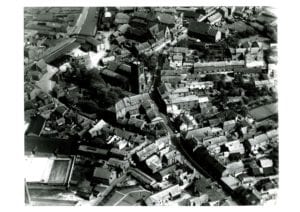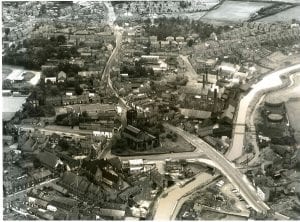© Copyright Middlewich Heritage Trust 2025. Registered Charity No 1161871. Company Limited by Guarantee No 9441581
Made with 🤍 by Bloom Digital Marketing Ltd.
This is a tracing taken from a survey of the Trent & Mersey canal, held by the Staffordshire Record Office that shows the location of various salt works. From later documents it has been possible to attribute names to them. How old the origins of these salt works were we do not know as this is the first evidence we have for the locations of post-medieval salt houses.
In terms of canal construction the Middlewich Branch of the Shropshire Union Canal is a late enterprise, opening in 1829; although it was one of the first branches of the Canal system to be conceived. The initial concept in constructing such a branch was to link the two main arterial canal networks – the Shropshire Union and The Trent & Mersey Canals. Furthermore, it was hoped that it would open trade with the industries in North Wales. Prior to finalising the route, a plan to construct a canal between Chester and Middlewich was conceived as far back as 1772 when the Chester Canal Company wished to take advantage of the lucrative salt and pottery trades.
This shows Middlewich before the railway. All canals have been constructed, the Middlewich branch by 1829 and the Wardle Canal by 1833. The suggested alternative routes for the Middlewich Branch are indicated and the Turnpike Roads are shown. The background is the 1840s Tithe Apportionment map with the same housing and street pattern depicted on the 1778 survey and salt works listed in Bagshaw’s 1850 Directory.
This shows how the same locations that were depicted in the 1778 survey have continued in use as salt works, although ownership has changed significantly. The background map is the 1st edition Ordnance Survey map. It also shows some of the salt related contemporary industries and the Railway which came to the Town in 1868.
This shows a significant change from historic salt works hugging the canal, to the development of much larger chemical works industry on the south side of the town. The importance of the Railway becomes considerably more essential for the economical distribution of salt.
Note the velvet works shown on the 1874-5 map has changed to a fustian works; the silk factory had closed and therefore velvet was no-longer easy to produce, so fustian was manufactured instead. Both velvet and fustian needed salt in their manufacture and finishing.
This shows a significant change from historic salt works hugging the canal, to the development of much larger chemical works industry on the south side of the town. The importance of the Railway becomes considerably more essential for the economical distribution of salt.
Note the velvet works shown on the 1874-5 map has changed to a fustian works; the silk factory had closed and therefore velvet was no-longer easy to produce, so fustian was manufactured instead. Both velvet and fustian needed salt in their manufacture and finishing.
The North West Canal Network
The Trent & Mersey Canal, constructed in 1777 cuts through the eastern partof the town centre, whilst the Middlewich Branch of the Shropshire Union Canal, opened in 1829 cuts through the southern part of the town, linking up with the Trent & Mersey via Britain’s shortest canal, the Wardle Branch which was opened in September 1833.
From the latter part of the 18th century to the latter part of the 20th century Middlewich was a significant junction for canal traffic, especially as the town was built on the wealth from the salt and dairy industries. The three canals link the town with local, regional and world markets. Canals at this time were considered good long-term investments and attracted a number of important industrialists of the day to put their money into these remarkable enterprises.
In Close Up…Maidenhills Area
1840 Tithe Map showing the “Dog Leg” of the Trent and Mersey Canal and Three locks area. Note the early existence of Canal House and its outbuildings, plus the Boat Yard South of Kings Lock.
In Close Up…Central Middlewich – The Town Wharf
The Town Wharf, east of Leadsmithy Street, dated 1911.The Wharf was much larger before the ‘new’ Town Bridge development, around 10 structures with two yards.
1928 Middlewich aerial v

Middlewich aerial view 2008
The Trust is established for the preservation and promotion of the heritage of Middlewich (including buildings, artefacts and archives) as a resource for the benefit of the residents of Cheshire East, of Cheshire West and Chester, and of the wider public. Middlewich Heritage Trust is a not for profit organisation and welcomes volunteers from all walks of life in a number of different areas.
There are many ways to get involved with Middlewich Heritage and volunteers are a crucial part of what we do. For more information on how to become a volunteer please contact us.
Mike Walton
Chair, Middlewich Heritage Trust
| Cookie | Duration | Description |
|---|---|---|
| yt-player-headers-readable | never | The yt-player-headers-readable cookie is used by YouTube to store user preferences related to video playback and interface, enhancing the user's viewing experience. |
| yt-remote-cast-available | session | The yt-remote-cast-available cookie is used to store the user's preferences regarding whether casting is available on their YouTube video player. |
| yt-remote-cast-installed | session | The yt-remote-cast-installed cookie is used to store the user's video player preferences using embedded YouTube video. |
| yt-remote-connected-devices | never | YouTube sets this cookie to store the user's video preferences using embedded YouTube videos. |
| yt-remote-device-id | never | YouTube sets this cookie to store the user's video preferences using embedded YouTube videos. |
| yt-remote-fast-check-period | session | The yt-remote-fast-check-period cookie is used by YouTube to store the user's video player preferences for embedded YouTube videos. |
| yt-remote-session-app | session | The yt-remote-session-app cookie is used by YouTube to store user preferences and information about the interface of the embedded YouTube video player. |
| yt-remote-session-name | session | The yt-remote-session-name cookie is used by YouTube to store the user's video player preferences using embedded YouTube video. |
| ytidb::LAST_RESULT_ENTRY_KEY | never | The cookie ytidb::LAST_RESULT_ENTRY_KEY is used by YouTube to store the last search result entry that was clicked by the user. This information is used to improve the user experience by providing more relevant search results in the future. |
| Cookie | Duration | Description |
|---|---|---|
| _ga | 1 year 1 month 4 days | Google Analytics sets this cookie to calculate visitor, session and campaign data and track site usage for the site's analytics report. The cookie stores information anonymously and assigns a randomly generated number to recognise unique visitors. |
| _ga_* | 1 year 1 month 4 days | Google Analytics sets this cookie to store and count page views. |
| Cookie | Duration | Description |
|---|---|---|
| PREF | 8 months | PREF cookie is set by Youtube to store user preferences like language, format of search results and other customizations for YouTube Videos embedded in different sites. |
| VISITOR_INFO1_LIVE | 6 months | YouTube sets this cookie to measure bandwidth, determining whether the user gets the new or old player interface. |
| VISITOR_PRIVACY_METADATA | 6 months | YouTube sets this cookie to store the user's cookie consent state for the current domain. |
| YSC | session | Youtube sets this cookie to track the views of embedded videos on Youtube pages. |
| yt.innertube::nextId | never | YouTube sets this cookie to register a unique ID to store data on what videos from YouTube the user has seen. |
| yt.innertube::requests | never | YouTube sets this cookie to register a unique ID to store data on what videos from YouTube the user has seen. |
| Cookie | Duration | Description |
|---|---|---|
| _pk_id.43236.731c | 1 year 1 month | Description is currently not available. |
| _pk_ses.43236.731c | 1 hour | Description is currently not available. |